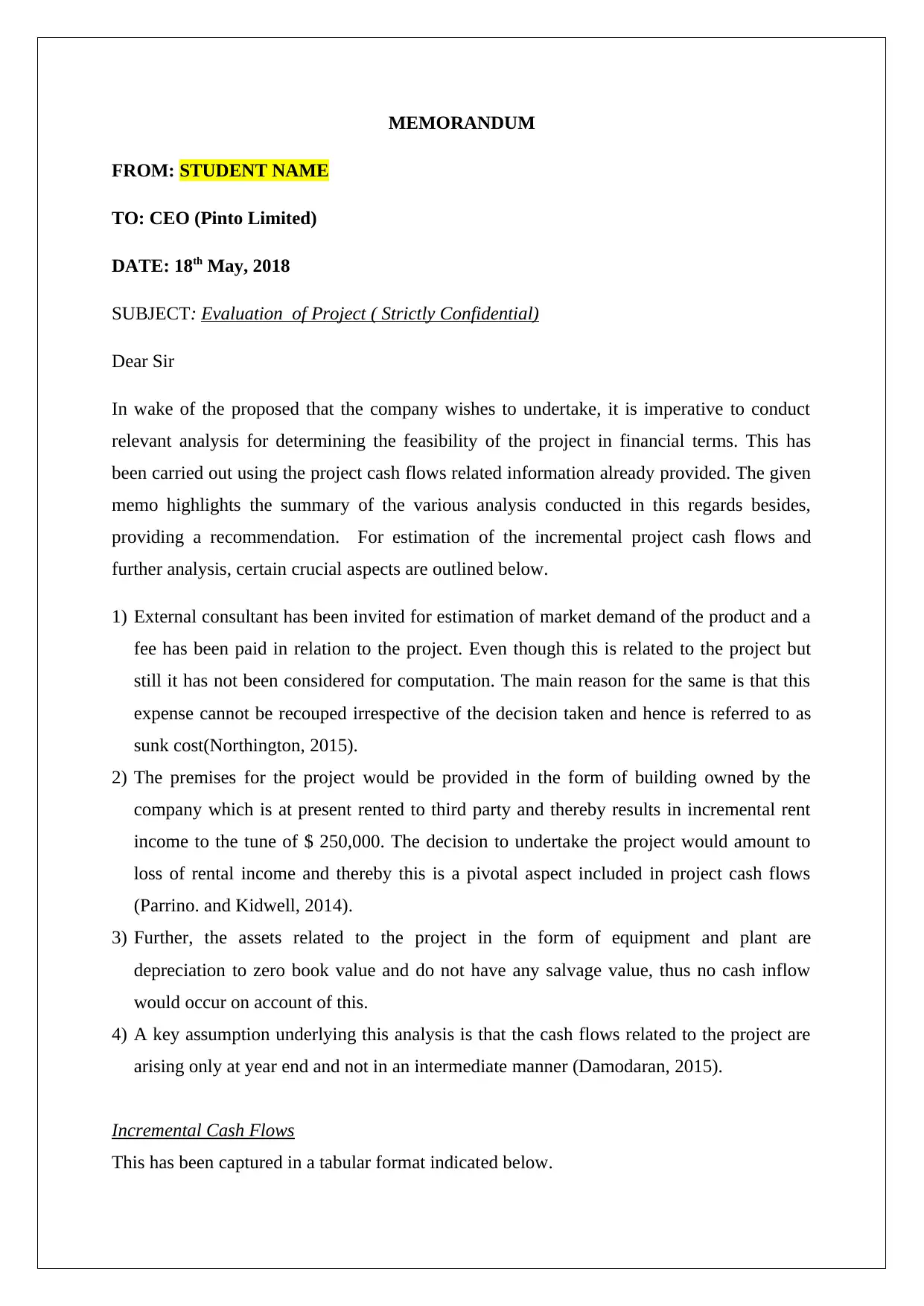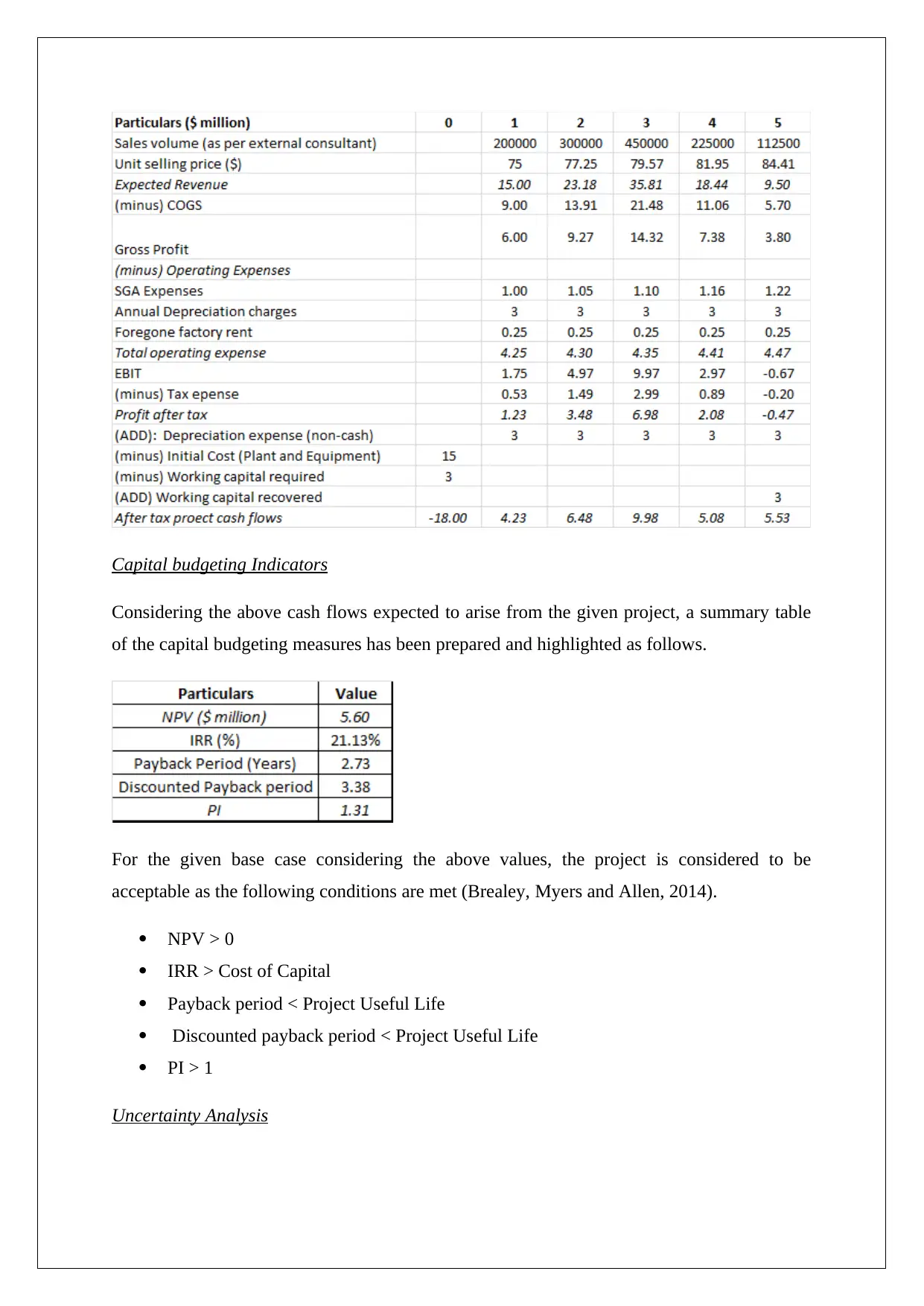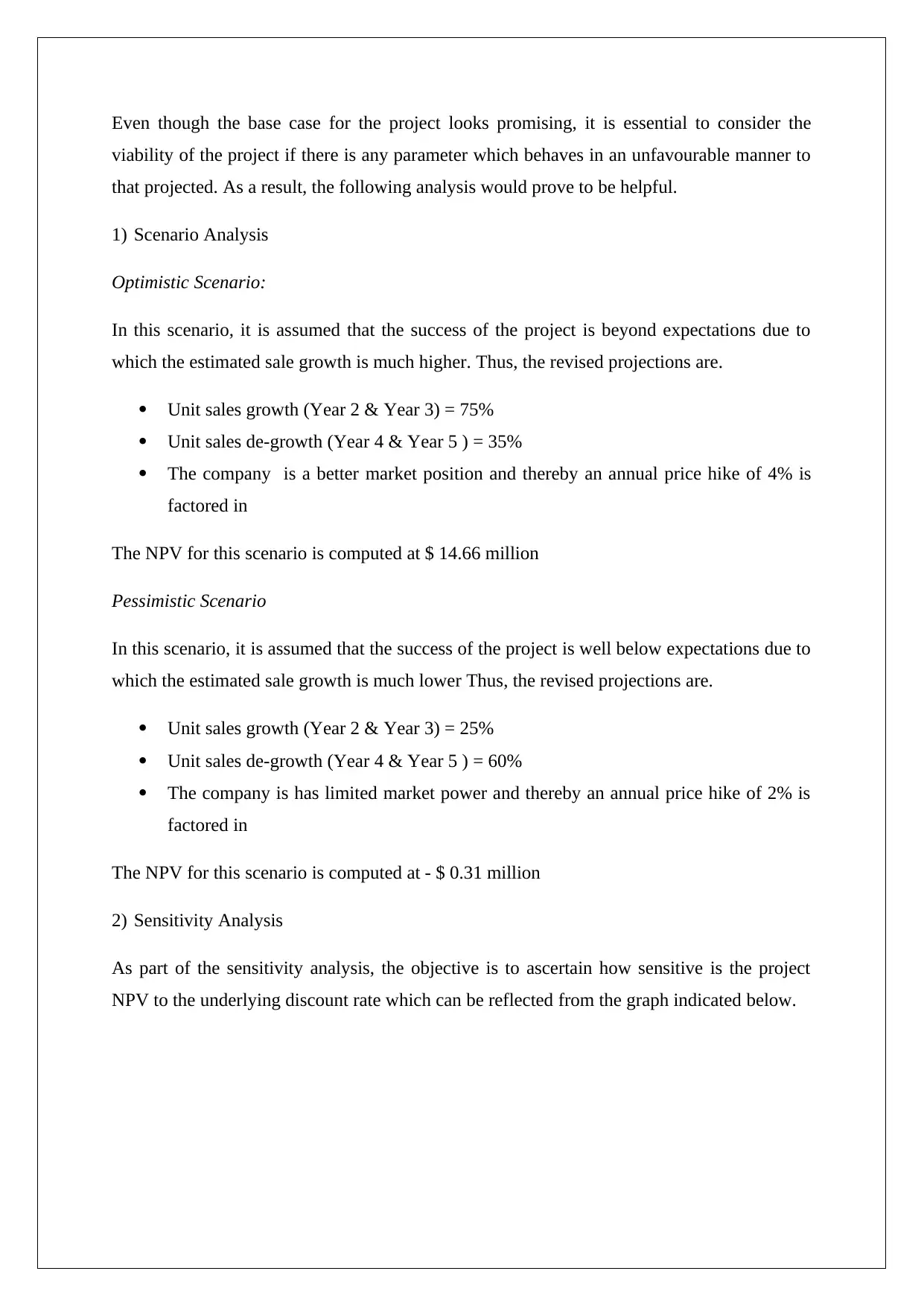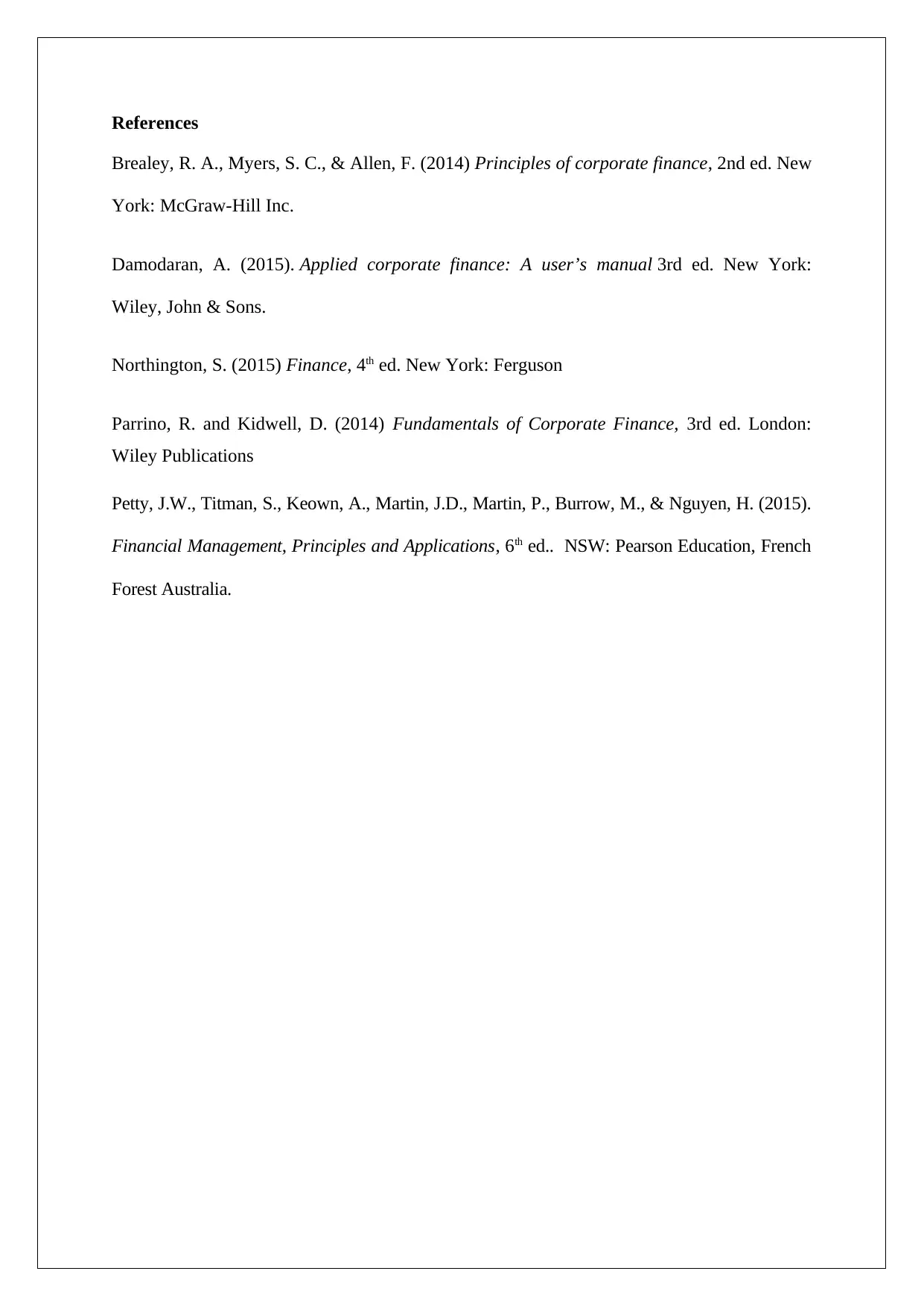ACC00716 Finance: Pinto Limited Project Evaluation Case Study
VerifiedAdded on 2023/06/12
|7
|1143
|347
Case Study
AI Summary
This finance case study provides a comprehensive evaluation of Pinto Limited's proposed project, addressing the company's need to combat increasing competition. The analysis includes calculations of Net Present Value (NPV), Internal Rate of Return (IRR), payback period, discounted payback period, and profitability index to determine the project's financial feasibility. The memorandum outlines key assumptions, such as the treatment of sunk costs and the consideration of lost rental income, and presents incremental cash flows in a tabular format. Uncertainty analysis, including scenario and sensitivity analyses, is conducted to assess the project's viability under different conditions. The study concludes with a recommendation to proceed with the project, based on the positive NPV and other favorable capital budgeting measures, supported by a detailed justification considering both base-case and alternative scenarios. Desklib offers a range of similar documents and past papers for students.

FINANCE
MEMORANDUM
STUDENT ID:
[Pick the date]
MEMORANDUM
STUDENT ID:
[Pick the date]
Paraphrase This Document
Need a fresh take? Get an instant paraphrase of this document with our AI Paraphraser

MEMORANDUM
FROM: STUDENT NAME
TO: CEO (Pinto Limited)
DATE: 18th May, 2018
SUBJECT: Evaluation of Project ( Strictly Confidential)
Dear Sir
In wake of the proposed that the company wishes to undertake, it is imperative to conduct
relevant analysis for determining the feasibility of the project in financial terms. This has
been carried out using the project cash flows related information already provided. The given
memo highlights the summary of the various analysis conducted in this regards besides,
providing a recommendation. For estimation of the incremental project cash flows and
further analysis, certain crucial aspects are outlined below.
1) External consultant has been invited for estimation of market demand of the product and a
fee has been paid in relation to the project. Even though this is related to the project but
still it has not been considered for computation. The main reason for the same is that this
expense cannot be recouped irrespective of the decision taken and hence is referred to as
sunk cost(Northington, 2015).
2) The premises for the project would be provided in the form of building owned by the
company which is at present rented to third party and thereby results in incremental rent
income to the tune of $ 250,000. The decision to undertake the project would amount to
loss of rental income and thereby this is a pivotal aspect included in project cash flows
(Parrino. and Kidwell, 2014).
3) Further, the assets related to the project in the form of equipment and plant are
depreciation to zero book value and do not have any salvage value, thus no cash inflow
would occur on account of this.
4) A key assumption underlying this analysis is that the cash flows related to the project are
arising only at year end and not in an intermediate manner (Damodaran, 2015).
Incremental Cash Flows
This has been captured in a tabular format indicated below.
FROM: STUDENT NAME
TO: CEO (Pinto Limited)
DATE: 18th May, 2018
SUBJECT: Evaluation of Project ( Strictly Confidential)
Dear Sir
In wake of the proposed that the company wishes to undertake, it is imperative to conduct
relevant analysis for determining the feasibility of the project in financial terms. This has
been carried out using the project cash flows related information already provided. The given
memo highlights the summary of the various analysis conducted in this regards besides,
providing a recommendation. For estimation of the incremental project cash flows and
further analysis, certain crucial aspects are outlined below.
1) External consultant has been invited for estimation of market demand of the product and a
fee has been paid in relation to the project. Even though this is related to the project but
still it has not been considered for computation. The main reason for the same is that this
expense cannot be recouped irrespective of the decision taken and hence is referred to as
sunk cost(Northington, 2015).
2) The premises for the project would be provided in the form of building owned by the
company which is at present rented to third party and thereby results in incremental rent
income to the tune of $ 250,000. The decision to undertake the project would amount to
loss of rental income and thereby this is a pivotal aspect included in project cash flows
(Parrino. and Kidwell, 2014).
3) Further, the assets related to the project in the form of equipment and plant are
depreciation to zero book value and do not have any salvage value, thus no cash inflow
would occur on account of this.
4) A key assumption underlying this analysis is that the cash flows related to the project are
arising only at year end and not in an intermediate manner (Damodaran, 2015).
Incremental Cash Flows
This has been captured in a tabular format indicated below.

Capital budgeting Indicators
Considering the above cash flows expected to arise from the given project, a summary table
of the capital budgeting measures has been prepared and highlighted as follows.
For the given base case considering the above values, the project is considered to be
acceptable as the following conditions are met (Brealey, Myers and Allen, 2014).
NPV > 0
IRR > Cost of Capital
Payback period < Project Useful Life
Discounted payback period < Project Useful Life
PI > 1
Uncertainty Analysis
Considering the above cash flows expected to arise from the given project, a summary table
of the capital budgeting measures has been prepared and highlighted as follows.
For the given base case considering the above values, the project is considered to be
acceptable as the following conditions are met (Brealey, Myers and Allen, 2014).
NPV > 0
IRR > Cost of Capital
Payback period < Project Useful Life
Discounted payback period < Project Useful Life
PI > 1
Uncertainty Analysis
⊘ This is a preview!⊘
Do you want full access?
Subscribe today to unlock all pages.

Trusted by 1+ million students worldwide

Even though the base case for the project looks promising, it is essential to consider the
viability of the project if there is any parameter which behaves in an unfavourable manner to
that projected. As a result, the following analysis would prove to be helpful.
1) Scenario Analysis
Optimistic Scenario:
In this scenario, it is assumed that the success of the project is beyond expectations due to
which the estimated sale growth is much higher. Thus, the revised projections are.
Unit sales growth (Year 2 & Year 3) = 75%
Unit sales de-growth (Year 4 & Year 5 ) = 35%
The company is a better market position and thereby an annual price hike of 4% is
factored in
The NPV for this scenario is computed at $ 14.66 million
Pessimistic Scenario
In this scenario, it is assumed that the success of the project is well below expectations due to
which the estimated sale growth is much lower Thus, the revised projections are.
Unit sales growth (Year 2 & Year 3) = 25%
Unit sales de-growth (Year 4 & Year 5 ) = 60%
The company is has limited market power and thereby an annual price hike of 2% is
factored in
The NPV for this scenario is computed at - $ 0.31 million
2) Sensitivity Analysis
As part of the sensitivity analysis, the objective is to ascertain how sensitive is the project
NPV to the underlying discount rate which can be reflected from the graph indicated below.
viability of the project if there is any parameter which behaves in an unfavourable manner to
that projected. As a result, the following analysis would prove to be helpful.
1) Scenario Analysis
Optimistic Scenario:
In this scenario, it is assumed that the success of the project is beyond expectations due to
which the estimated sale growth is much higher. Thus, the revised projections are.
Unit sales growth (Year 2 & Year 3) = 75%
Unit sales de-growth (Year 4 & Year 5 ) = 35%
The company is a better market position and thereby an annual price hike of 4% is
factored in
The NPV for this scenario is computed at $ 14.66 million
Pessimistic Scenario
In this scenario, it is assumed that the success of the project is well below expectations due to
which the estimated sale growth is much lower Thus, the revised projections are.
Unit sales growth (Year 2 & Year 3) = 25%
Unit sales de-growth (Year 4 & Year 5 ) = 60%
The company is has limited market power and thereby an annual price hike of 2% is
factored in
The NPV for this scenario is computed at - $ 0.31 million
2) Sensitivity Analysis
As part of the sensitivity analysis, the objective is to ascertain how sensitive is the project
NPV to the underlying discount rate which can be reflected from the graph indicated below.
Paraphrase This Document
Need a fresh take? Get an instant paraphrase of this document with our AI Paraphraser

While the NPV does show high sensitivity to the project cost of capital but considering that
the NPV becomes negative only when discount rate breaches 21%, the cushion available for
the project is quite ample since this much deviation in cost of capital would be considered as
unprecedented and hence rare (Petty et. al., 2015).
Recommendation
The analysis carried out above in context of the proposed project provides significant
evidence to recommend going ahead with the proposed project. The relevant factors that
provide support are indicated below (Brealey, Myers and Allen, 2014).
1) The generation of positive NPV thereby reflecting the shareholders; wealth enhancing on
the back of the project. A similar reading can also be drawn from other measures such as
IRR, payback period (normal & discounted) along with profitability index.
2) Even when there was significant deviation from the projected sales volume coupled with
lower prices, then also the NPV became marginally negative only. However considering
that the likelihood of the pessimistic scenario is quite less, then considering the positive
NPV in base and optimistic scenario, the expected project NPV would be positive.
3) The amount of cushion available with regards to adverse movements in discount rate is
quite high and it is highly improbably that such an increase in the discount rate would be
witnessed.
the NPV becomes negative only when discount rate breaches 21%, the cushion available for
the project is quite ample since this much deviation in cost of capital would be considered as
unprecedented and hence rare (Petty et. al., 2015).
Recommendation
The analysis carried out above in context of the proposed project provides significant
evidence to recommend going ahead with the proposed project. The relevant factors that
provide support are indicated below (Brealey, Myers and Allen, 2014).
1) The generation of positive NPV thereby reflecting the shareholders; wealth enhancing on
the back of the project. A similar reading can also be drawn from other measures such as
IRR, payback period (normal & discounted) along with profitability index.
2) Even when there was significant deviation from the projected sales volume coupled with
lower prices, then also the NPV became marginally negative only. However considering
that the likelihood of the pessimistic scenario is quite less, then considering the positive
NPV in base and optimistic scenario, the expected project NPV would be positive.
3) The amount of cushion available with regards to adverse movements in discount rate is
quite high and it is highly improbably that such an increase in the discount rate would be
witnessed.

.Yours Sincerely
STUDENT NAME
STUDENT NAME
⊘ This is a preview!⊘
Do you want full access?
Subscribe today to unlock all pages.

Trusted by 1+ million students worldwide

References
Brealey, R. A., Myers, S. C., & Allen, F. (2014) Principles of corporate finance, 2nd ed. New
York: McGraw-Hill Inc.
Damodaran, A. (2015). Applied corporate finance: A user’s manual 3rd ed. New York:
Wiley, John & Sons.
Northington, S. (2015) Finance, 4th ed. New York: Ferguson
Parrino, R. and Kidwell, D. (2014) Fundamentals of Corporate Finance, 3rd ed. London:
Wiley Publications
Petty, J.W., Titman, S., Keown, A., Martin, J.D., Martin, P., Burrow, M., & Nguyen, H. (2015).
Financial Management, Principles and Applications, 6th ed.. NSW: Pearson Education, French
Forest Australia.
Brealey, R. A., Myers, S. C., & Allen, F. (2014) Principles of corporate finance, 2nd ed. New
York: McGraw-Hill Inc.
Damodaran, A. (2015). Applied corporate finance: A user’s manual 3rd ed. New York:
Wiley, John & Sons.
Northington, S. (2015) Finance, 4th ed. New York: Ferguson
Parrino, R. and Kidwell, D. (2014) Fundamentals of Corporate Finance, 3rd ed. London:
Wiley Publications
Petty, J.W., Titman, S., Keown, A., Martin, J.D., Martin, P., Burrow, M., & Nguyen, H. (2015).
Financial Management, Principles and Applications, 6th ed.. NSW: Pearson Education, French
Forest Australia.
1 out of 7
Related Documents
Your All-in-One AI-Powered Toolkit for Academic Success.
+13062052269
info@desklib.com
Available 24*7 on WhatsApp / Email
![[object Object]](/_next/static/media/star-bottom.7253800d.svg)
Unlock your academic potential
Copyright © 2020–2025 A2Z Services. All Rights Reserved. Developed and managed by ZUCOL.





